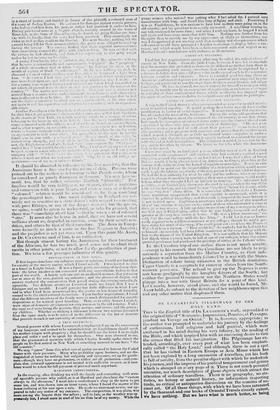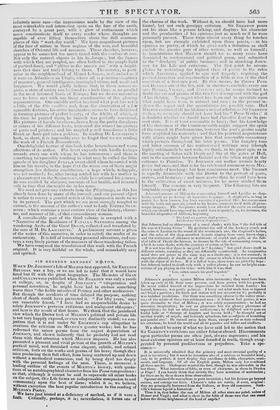DE LAM ARTINE'S PILGRIMAGE TO TILE 11011 LAND.
TIIIS is the English title of DE L ALM A RTI NE'S work, superadded to the original title of" Souvenirs, Impressions, Penses, et Paysages, pendant tin Voyage en Orient." It is, however, appropriate; as the author was prompted to undertake his journey by the feelings of enthusiasm, half religious and half poetical, which were awakened in his mind during his very infancy, by the reading of the Bible, and which inspired hint with an unceasing desire to visit the scenes that filled his imagination. His Pilgrimage has ex- tended, accordingly, over every part of what has been emphati- cally called " the Holy Land ;" and although there is not a spot that lie has visited in Eastern Europe or Asia Minor which has not been explored by a long succession of travellers, yet his book is full of novelty, front the peculiar object with which he undertook his journey, and the impress of his poetical temperament and genius which is stamped on every page of it. There is not much personal narrative, nor much description of Pose 'Nees which attract the attention of ordinary travellers. There is no geography, no sta- tistics, no botany or natural history, no information respecting trade, no critical or antiquarian discussions on the remains of an- cient art. Of all these things, with which we have been saturated by the thousand-and-one books of Oriental Travels already extant, we have nothing. But we have what is much better, as being infinitely more rare—the impressions made by the view of the most remarkable and interesting spots on the face of the earth, conveyed by a great poet, with a glow of enthusiasm which must communicate itself to every reader whose thoughts are capable of ever lifting themselves above the dull common- places of this " work-day world." We have nia,guificent pictures of the face of nature in those regions of the sun, and beautiful sketches of Oriental life and manners. These sketches, however, appear to be somewhat too much tinted with the couleur de rose. Not only the natural objects in his lat.dscapes, but the figures with which they are peopled, are often bathed in the purple light of poetical fancy, and " glitter in the muse's ray " with a bright- ness that does not truly belong to them. The country, in parti- cular in the neighbourhood of Mount Lebanon, is described as if it were an Atlantis or an Utopia, where all is pi imitive simplicity cf manners, general intelligence, umningled virtue, and unalloyed happiness. 11re would gladly believe that, in those remote re- gions, a state of society can b found to v.•hich there is no paralld in the most favoured lands of Europe; but we do not remember ever to have met with any thing corroborative of this glowing rept escntat ion. Our amiable author has (and what pet has nut?) a little of the tote c.ralbY and, frLim the observation of a II w agreeable features, his active imagination seems to have deliehted in forming pictures of perfect beauty, of time fidelity of which, at the time he painted them, he himself was perfectly convinced. His pictures of female loveliness, draw ii from the pretty daughters or sisters of his differetit hosts, transcend the unno-t itmginings of poets and painters; and his magical limed transforms a little Greek or Arab girl into a goddess. In reading DE LAMARTINE'S book, in short, it is impossible ever to forget that we are reading the work of a French Ronundicisle.
One delightful feature of this book is the benevolence and warm affections of its author. Pis heart expands with kindly feelings towards every one with whom he has intercourse : and there is something inexpressibly touching in what may be called the little episode of his daughter JULIA, a sweet child whom he carried with him on his travels, in the hope that the warm soil of Syria might strengthen her delicate eonstitution,—a hope which, uuhappily, was not realized; for, after having settled her with her mother in a pleasant spot on the Syrian coast, while he continued his journey, he was recalled by alarming accounts of her health, and returned only in time that she might (lie in his arms. We need not give any extracts from the Pilgrimage, as this has already been done by many of the journals, and our present object is rather to convey a general notion of the impression made on us by its perusal. The part which we are most strongly tempted to extract, is the account of the author's visit to Lady ESTHER STAN- HOPE ; which contains a most curious view of the history, charac- ter, and manner of life, of that extraordinary woman.
A considerable part of the third volume is occupied with a "Narrative of the Residence of FaTasLA SAYEGHIR among the wandering Arabs of the Great Desert, collected and translated by the care of M. DE LAMARTINE.'' A preliminary account is given of the writer of this narrative, in order to satisfy the reader of its authenticity. It is full of interesting personal adventure, and con- veys a very lively picture of the manners of those wandering tribes.
We have compared the translation of this work with the French original. It is very faithful on the whole, and remarkably easy and spirited.



























 Previous page
Previous page